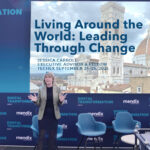I was intrigued by an interview with Jennifer Pahlka (author of Re-coding America: Why Government Is Failing in the Digital Age and How We Can Do Better1) where she told the story about an Unemployment Insurance Scheme that had 6,700 technology design requirements.
Among the challenges in this programme of work was a 90-year-old policy with 90 years of additions. The outcome was a ‘concrete boat’. At one point, the scheme was behind by millions of claims. Imagine being one of those customers.
This article is inspired by another from 1980 with the same title.2 It got me thinking about the word ‘organization’. When I look up the definition, I find:‘an organized group of people with a particular purpose, such as a business or a government department.’ Also, as a verb: the action of organizing something.
Disorganization as a way of life
We know the evil that is ‘disorganization’, but are we as familiar with the disaster that is well-intentioned formality and work structures that render ‘organization’ impossible (while people become busier and busier.) As far back as 1980, those authors quote Herbert Simon (a 1977 Nobel laureate) who stated that “most organizations cannot maximize – the goals are really not that clear. Even if they were, most business managers do not have access to complete information….(and)….. operate with a set of relatively simple decision rules in order to limit the information they really need …(and)…. the rules we use in order to get on with it in big organizations limit our ability to optimize anything.”
More recently, Sam Chakraborty published an article of the same title using this quote: “Structure is a tool, not a panacea.”3 Yet, you think about organizational structure and immediately what comes to mind is MS PowerPoint’s ‘dangling box’ template perpetuating a static top-down approach in a matrix, nuanced world. I don’t think this is a digital era issue; I think it is a human issue.
Much attention has been given recently to employee burnout, and key cause of stress remain:
- process complexity that stymies action
- layers of bureaucracy
- imposed changes that take things backwards
For people to do their best work, they need to end each workday feeling they have achieved something and made a difference. These states are stress antidotes, yet ‘structures’ and so called ‘organization’ can make this impossible.
People’s roles are increasingly blurred. In a matrix world, where everyone is reporting to a manager but also expected to do tasks for a myriad of other individuals and/or teams, the most dominant prevail.
Agile ways of working have gone a long way to getting things done, but too often collide with other organization systems which leave the customer out in the cold and employees frustrated as yet again they are left to deal with distressing customer complaints.
Organizing – how?
What is the answer? We do need an organizing mechanism to:
- Focus human attention and intelligence
- Filter data into information that can guide human effort
- Fulfil the ‘organization’ purpose
We cannot afford to continue ‘organizing’ our way round and round in circles. Truman said about the presidency: “You issue orders from this office and if you can find out what happens to them after that, you’re a better man than I am.” If you want a modern study of this phenomenon, watch the satirical “Utopia” on Netflix.4
This hits all of us in our back pocket. Recent New Zealand examples include a light rail project that cost US$122M with no start to any work, a feasibility study for a cycle lane on a harbor bridge that cost $30M to decided not to proceed, and a single pedestrian crossing that cost US$150K. (Bear in mind that the whole of New Zealand is comparable in population size to an Australian city.). This does a disservice to funders, employees and customers – to citizens. It would appear that organizations are where value goes to die.
Hamel and Zanini describe it well:
“At some deep level, we know that life is too short to work on inconsequential problems. We know the sages were right when they commended “the road less traveled.” Solving new problems and forging new paths—this is what we were born to do.…… The problem is that your organization, like most, is inherently hidebound, repressive, and fainthearted.” 5 (Part 1 Page 3.)
The quest for ‘organization’
In our search for simplicity – organizational Swedish death cleaning – the answer is not to regress to a command-and-control structure which for decades has led to waste and underachievement. This is the illusion of control. It puts a heroic individual at the top, resulting in the organization that Truman described. Rather, you are better to place organizational Purpose at the top of the structure, with every person subject to what the organization is there to do. As one client put it: Purpose-led; Outcomes-driven.
Every strategy, objective and tactic can be tested against the extent to which the Purpose is furthered. Assess value against two end points of a tight rope: Customer experience and value for money at the one end, and Shareholder realization of sustainable returns at the other, including brand/reputation value.
The tension along the tight rope is represented by smart people making quick work of adding value: doing the right things in the best way; where egos have no place.
Organization, anyone?
Sources:
- Pahlka, Jennifer. Recoding America. Why Government Is Failing in the Digital Age and How We Can Do Better. Metropolitan Books. https://www.amazon.com.au/Recoding-America-Government-Failing-Digital-ebook/dp/B0B8644ZGY
- “Structure is not organization”. Robert H. Waterman Jr., Thomas, J., Peters, Julien, R. Phillips. 1980.
https://managementmodellensite.nl/webcontent/uploads/Structure-is-not-organization.pdf - “Structure is not Organization (Neither is it a panacea)”. Sam Chakraborty. 22 Nov 2023 https://www.linkedin.com/pulse/structure-organization-neither-panacea-sam-chakraborty-azpze/
- Utopia – Netflix series. 2014. Tasked with rushed infrastructure projects, employees of the Nation Building Authority walk a tightrope between big ambition and government bureaucracy. Creators: Rob Sitch, Santo Cilauro, Tom Gleisner. https://www.netflix.com/nz/title/80063251
- Hamel, Gary and Michele Zanini. Humanocracy. Creating organizations as amazing as the people in them. Harvard Business Review Press.
Tag/s:Business TransformationDigital EnterpriseOrganizational Change





